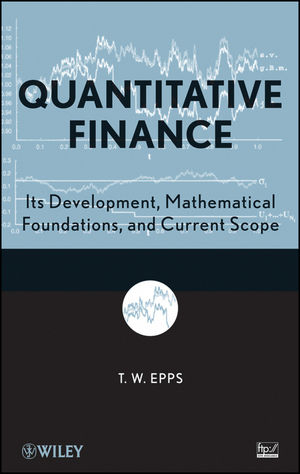Quantitative Finance: Its Development, Mathematical Foundations, and Current ScopeISBN: 978-0-470-43199-3
Hardcover
448 pages
March 2009
 |
||||||
PART I: PERSPECTIVE AND PREPARATION.
1. Introduction and Overview.
1.1 An Elemental View of Assets and Markets.
1.1.1 Assets as Bundles of Claims.
1.1.2 Financial Markets as Transportation Agents.
1.1.3 Why Is Transportation Desirable?
1.1.4 What Vehicles Are Available?
1.1.5 What Is There to Learn about Assets and Markets?
1.1.6 Why the Need for Quantitative Finance?
1.2 Where We Go from Here.
2. Tools from Calculus and Analysis.
2.1 Some Basics from Calculus.
2.2 Elements of Measure Theory.
2.2.1 Sets and Collections of Sets.
2.2.2 Set Functions and Measures.
2.3 Integration.
2.3.1 Riemann-Stieltjes.
2.3.2 Lebesgue/Lebesgue-Stieltjes.
2.3.3 Properties of the Integral.
2.4 Changes of Measure.
3. Probability.
3.1 Probability Spaces.
3.2 Random Variables and Their Distributions.
3.3 Independence of R.V.s.
3.4 Expectation.
3.4.1 Moments.
3.4.2 Conditional Expectations and Moments.
3.4.3 Generating Functions.
3.5 Changes of Probability Measure.
3.6 Convergence Concepts.
3.7 Laws of Large Numbers and Central Limit Theorems.
3.8 Important Models for Distributions.
3.8.1 Continuous Models.
3.8.2 Discrete Models.
PART II: PORTFOLIOS AND PRICES.
4. Interest and Bond Prices.
4.1 Interest Rates and Compounding.
4.2 Bond Prices, Yields, and Spot Rates.
4.3 Forward Bond Prices and Rates.
4.4 Empirical Project #1.
5. Models of Portfolio Choice.
5.1 Models That Ignore Risk.
5.2 Mean-Variance Portfolio Theory.
5.2.1 Mean-Variance ‘Efficient’ Portfolios.
5.2.2 The Single-Index Model.
5.3 Empirical Project #2.
6. Prices in a Mean-VarianceWorld.
6.1 The Assumptions.
6.2 The Derivation.
6.3 Interpretation.
6.4 Empirical Evidence.
6.5 Some Reflections.
7. Rational Decisions under Risk.
7.1 The Setting and the Axioms.
7.2 The Expected-Utility Theorem.
7.3 Applying Expected-Utility Theory.
7.3.1 Implementing EU Theory in Financial Modeling.
7.3.2 Inferring Utilities and Beliefs.
7.3.3 Qualitative Properties of Utility Functions.
7.3.4 Measures of Risk Aversion.
7.3.5 Examples of Utility Functions.
7.3.6 Some Qualitative Implications of the EU Model.
7.3.7 Stochastic Dominance.
7.4 Is the Markowitz Investor Rational?
7.5 Empirical Project #3.
8. Observed Decisions under Risk.
8.1 Evidence about Choices under Risk.
8.1.1 Allais? Paradox.
8.1.2 Prospect Theory.
8.1.3 Preference Reversals.
8.1.4 Risk Aversion and Diminishing Marginal Utility.
8.2 Toward ‘Behavioral’ Finance.
9. Distributions of Returns.
9.1 Some Background.
9.2 The Normal/Lognormal Model.
9.3 The Stable Model.
9.4 Mixture Models.
9.5 Comparison and Evaluation.
10. Dynamics of Prices and Returns.
10.1 Evidence for First-Moment Independence.
10.2 Random Walks and Martingales.
10.3 Modeling Prices in Continuous Time.
10.3.1 Poisson and Compound-Poisson Processes.
10.3.2 Brownian Motions.
10.3.3 Martingales in Continuous Time.
10.4 Empirical Project #4.
11. Stochastic Calculus.
11.1 Stochastic Integrals.
11.1.1 Ito Integrals with Respect to a B.m.
11.1.2 From It^o Integrals to It^o Processes.
11.1.3 Quadratic-Variations of It^o Processes.
11.1.4 Integrals with Respect to It^o Processes.
11.2 Stochastic Differentials.
11.3 Ito’s Formula for Differentials.
11.3.1 Functions of a B.m. Alone.
11.3.2 Functions of Time and a B.m.
11.3.3 Functions of Time and General It^o Processes.
12. Portfolio Decisions over Time.
12.1 The Consumption-Investment Problem.
12.2 Dynamic Portfolio Decisions.
12.2.1 Optimizing via Dynamic Programming.
12.2.2 A Formulation with Additively-Separable Utility.
13. Optimal Growth.
13.1 Optimal Growth in Discrete Time.
13.2 Optimal Growth in Continuous Time.
13.3 Some Qualifications.
13.4 Empirical Project #5.
14. Dynamic Models for Prices.
14.1 Dynamic Optimization (Again).
14.2 Static Implications: The CAPM.
14.3 Dynamic Implications: The Lucas Model.
14.4 Assessment.
14.4.1 The Puzzles.
14.4.2 The Patches.
14.4.3 Some Reflections.
15. Efficient Markets.
15.1 Event Studies.
15.1.1 Methods.
15.1.2 A Sample Study.
15.2 Dynamic Tests.
15.2.1 Early History.
15.2.2 Implications of the Dynamic Models.
15.2.3 Excess Volatility.
PART III: PARADIGMS FOR PRICING.
16. Static Arbitrage Pricing.
16.1 Pricing Paradigms: Optimization vs. Arbitrage.
16.2 The APT.
16.3 Arbitraging Bonds.
16.4 Pricing a Simple Derivative Asset.
17. Dynamic Arbitrage Pricing.
17.1 Dynamic Replication.
17.2 Modeling Prices of the Assets.
17.3 The Fundamental P.D.E.
17.3.1 The Feynman-Kac Solution to the P.D.E.
17.3.2 Working out the Expectation.
17.4 Allowing Dividends and Time-Varying Rates.
18. Properties of Option Prices.
18.1 Bounds on Prices of European Options.
18.2 Properties of Black-Scholes Prices.
18.3 Delta Hedging.
18.4 Does Black-Scholes StillWork?
18.5 American-Style Options.
18.6 Empirical Project #6.
19. Martingale Pricing.
19.1 Some Preparation.
19.2 Fundamental Theorem of Asset Pricing.
19.3 Implications for Pricing Derivatives.
19.4 Applications.
19.5 Martingale vs. Equilibrium Pricing.
19.6 Numeraires, Short Rates, and E.M.M.s.
19.7 Replication & Uniqueness of the E.M.M.
20. Modeling Volatility.
20.1 Models with Price-Dependent Volatility.
20.1.1 The C.E.V. Model.
20.1.2 The Hobson-Rogers Model.
20.2 ARCH/GARCH Models.
20.3 Stochastic Volatility.
20.4 Is Replication Possible?
21. Discontinuous Price Processes.
21.1 Merton’s Jump-Diffusion Model.
21.2 The Variance-Gamma Model.
21.3 Stock Prices as Branching Processes.
21.4 Is Replication Possible?
22. Options on Jump Processes.
22.1 Options under Jump-Diffusions.
22.2 A Primer on Characteristic Functions.
22.3 Using Fourier Methods to Price Options.
22.4 Applications to Jump Models.
23. Options on S.V. Processes.
23.1 Independent Price/Volatility Shocks.
23.2 Dependent Price/Volatility Shocks.
23.3 Adding Jumps to the S.V. Model.
23.4 Further Advances.
23.5 Empirical Project #7.
Solutions to Exercises.
References.
Index.



